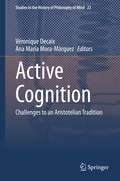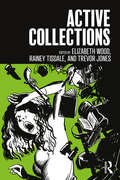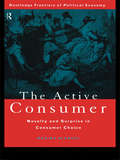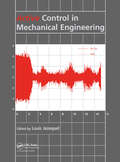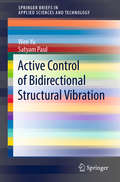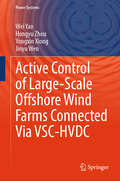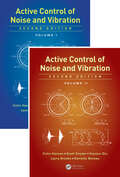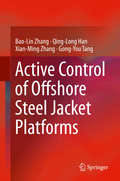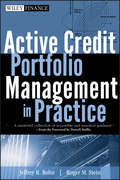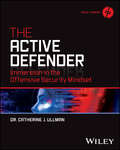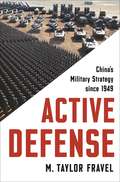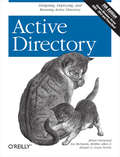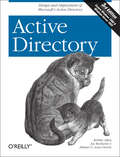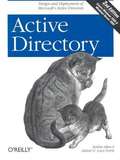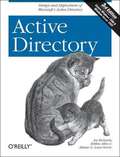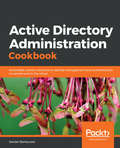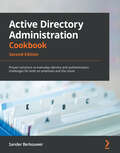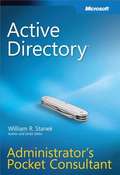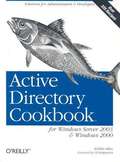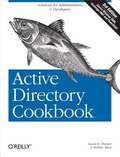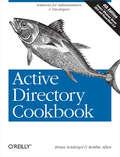- Table View
- List View
Active Coaching and Follow-Up: Getting down to Business
by Richard LueckeActive coaching is a collaborative effort, requiring both parties to be in agreement about goals, an action plan, and approach. This chapter addresses the one-on-one basics of coaching and explains how to handle feedback and achieve mutual satisfaction. Each coaching session is different, and this chapter offers tips on how to use the best approach to suit the situation.
Active Cognition: Challenges to an Aristotelian Tradition (Studies in the History of Philosophy of Mind #23)
by Véronique Decaix Ana María Mora-MárquezThis edited work draws on a range of contributed expertise to trace the fortune of an Aristotelian thesis over different periods in the history of philosophy. It presents eight cases of direct or indirect challenges to the Aristotelian passive account of human cognition, taking the reader from late antiquity to the 20th century. Chapters analyse the (often indirect) effect of Aristotle’s account of cognition on later periods. In his influential De anima, Aristotle describes human cognition, both sensitive and intellectual, as the reception of a form in the cognitive subject. Aristotle’s account has been commonly interpreted as fundamentally passive – the cognitive subject is a passive actor upon which a cognitive process is acted by the object. However, at least from the time of Alexander of Aphrodisias onwards, this interpretation has been challenged by authors who posit a fundamental active aspect of cognition. Readers will discover how one or more of three concerns – ontological superiority, direct realism and moral responsibility – drive the active accounts of cognition. Contributed chapters from top scholars examine how these three concerns lead thinkers to take issue with the idea that cognition is a passive process. The authors consider Jesuit accounts of cognition, Malebranche on judgment, and Wittgenstein on perception, as well as Stumpf on active cognition, among other relevant works. This book is ideally suited to scholars of philosophy, especially those with an interest in medieval epistemology, the influence of Aristotle, philosophy of mind and theories of cognition.
Active Collections
by Elizabeth Wood Rainey Tisdale Trevor JonesIn recent years, many museums have implemented sweeping changes in how they engage audiences. However, changes to the field’s approaches to collections stewardship have come much more slowly. Active Collections critically examines existing approaches to museum collections and explores practical, yet radical, ways that museums can better manage their collections to actively advance their missions. Approaching the question of modern museum collection stewardship from a position of "tough love," the authors argue that the museum field risks being constrained by rigid ways of thinking about objects. Examining the field’s relationship to objects, artifacts, and specimens, the volume explores the question of stewardship through the dissection of a broad range of issues, including questions of "quality over quantity," emotional attachment, dispassionate cataloging, and cognitive biases in curatorship. The essays look to insights from fields as diverse as forest management, library science, and the psychology of compulsive hoarding, to inform and innovate collection practices. Essay contributions come from both experienced museum professionals and scholars from disciplines as diverse as psychology, education, and history. The result is a critical exploration that makes the book essential reading for museum professionals, as well as those in training.
The Active Consumer: Novelty and Surprise in Consumer Choice (Routledge Frontiers of Political Economy #No.20)
by Marina BianchiThe Active Consumer discusses how consumers seem to delight in trying new solutions and exploring new combinatory possibilities. This book provides an economic-theoretical understanding of this phenomenon and the many ways in which innovation can structure consumer choice. The authors show from different points of view how central novelty can be in consumer behaviour, how it relates to technical change and how new consumer capabilities are developed and organized.
Active Control in Mechanical Engineering: Proceedings of the MV2 Convention on Active Control in Mechanical Engineering, Lyon, France, 22-23 October 1997.
by Louis JezequelThe introduction of active control in structural dynamics has led to a number of developments over wide-ranging industrial domains. This work investigates this area and examines a number of topics including: smart materials and structures; new strategies of active control and its applications.
Active Control of Bidirectional Structural Vibration (SpringerBriefs in Applied Sciences and Technology)
by Wen Yu Satyam PaulThis book focuses on safeguarding civil structures and residents from natural hazards such as earthquakes through the use of active control. It proposes novel proportional-derivative (PD) and proportional-integral-derivative (PID) controllers, as well as discrete-time sliding mode controllers (DSMCs) for the vibration control of structures involving nonlinearities. Fuzzy logic techniques are used to compensate for nonlinearities. The first part of the book addresses modelling and feedback control in inelastic structures and presents a design for PD/PID controllers. In the second part, classical PD/PID and type-2 fuzzy control techniques are combined to compensate for uncertainties in the structures of buildings. The methodology for tuning the gains of PD/PID is obtained using Lyapunov stability theory, and the system’s stability is verified. Lastly, the book puts forward a DSMC design that does not require system parameters, allowing it to be more flexibly applied. All program codes used in the paper are presented in a MATLAB®/Simulink® environment. Given its scope, the book will be of interest to mechanical and civil engineers, and to advanced undergraduate and graduate engineering students in the areas of structural engineering, structural vibration, and advanced control.
Active Control of Large-Scale Offshore Wind Farms Connected Via VSC-HVDC (Power Systems)
by Wei Yao Hongyu Zhou Yongxin Xiong Jinyu WenThis book provides a detailed study of the active control methods for large-scale offshore wind farms connected via flexible high-voltage direct current (VSC-HVDC) transmission systems. Firstly, it introduces the basic structure and fundamental control of offshore wind farms connected via VSC-HVDC systems, and proposes a vector modeling method for them. Furthermore, it analyzes the fault characteristics of offshore wind farms connected via VSC-HVDC systems under different fault conditions, and proposes an active fault suppression method based on energy control. Finally, it introduces the method of offshore wind farms connected via VSC-HVDC systems to support the grid frequency. From basic concepts to self-active safety control, and then to active support control of the grid, this book systematically introduces the active control methods of large-scale offshore wind farms connected via VSC-HVDC systems. In particular, it introduces some advanced control methods from the perspective of energy. This book is a useful reference for undergraduate and graduate students interested in offshore wind farms and VSC-HVDC, researchers studying fault ride-through and active frequency support of offshore wind farms connected via VSC-HVDC systems, as well as engineers.
Active Control of Magneto-hydrodynamic Instabilities in Hot Plasmas (Springer Series on Atomic, Optical, and Plasma Physics #83)
by Valentin IgochineDuring the past century, world-wide energy consumption has risen dramatically, which leads to a quest for new energy sources. Fusion of hydrogen atoms in hot plasmas is an attractive approach to solve the energy problem, with abundant fuel, inherent safety and no long-lived radioactivity. However, one of the limits on plasma performance is due to the various classes of magneto-hydrodynamic instabilities that may occur. The physics and control of these instabilities in modern magnetic confinement fusion devices is the subject of this book. Written by foremost experts, the contributions will provide valuable reference and up-to-date research reviews for "old hands" and newcomers alike.
Active Control of Noise and Vibration
by Scott Snyder Colin Hansen Danielle Moreau Xiaojun Qiu Laura BrooksIntegrating active control of both sound and vibration, this comprehensive two-volume set combines coverage of fundamental principles with the most recent theoretical and practical developments. The authors explain how to design and implement successful active control systems in practice and detail the pitfalls one must avoid to ensure a reliable and stable system. Extensively revised, updated, and expanded throughout, the second edition reflects the advances that have been made in algorithms, DSP hardware, and applications since the publication of the first edition.
Active Control of Offshore Steel Jacket Platforms
by Gong-You Tang Xian-Ming Zhang Qing-Long Han Bao-Lin Zhang<p>Offshore platforms are widely used to explore, drill, produce, store and transport ocean resources, and are usually subjected to environmental loading, which can lead to deck facility failure and platform fatigue failure, inefficient operation and even crew discomfort. In order to ensure the reliability and safety of offshore platforms, it is important to explore effective ways of suppressing the vibration of offshore platforms. <p>This book provides a brief overview of passive, semi-active and active control schemes to deal with vibration of offshore platforms. It then comprehensively and systematically discusses the recent advances in active systems with optimal, sliding model, delayed feedback and network-based control. Intended for readers interested in vibration control and ocean engineering, it is particularly useful for researchers, engineers, and graduate students in the fields of system and control community, vibration control, ocean engineering, as well as electrical and electronic engineering.</p>
Active Credit Portfolio Management in Practice
by Roger M. Stein Jeffrey R. BohnState-of-the-art techniques and tools needed to facilitate effective credit portfolio management and robust quantitative credit analysisFilled with in-depth insights and expert advice, Active Credit Portfolio Management in Practice serves as a comprehensive introduction to both the theory and real-world practice of credit portfolio management. The authors have written a text that is technical enough both in terms of background and implementation to cover what practitioners and researchers need for actually applying these types of risk management tools in large organizations but which at the same time, avoids technical proofs in favor of real applications. Throughout this book, readers will be introduced to the theoretical foundations of this discipline, and learn about structural, reduced-form, and econometric models successfully used in the market today. The book is full of hands-on examples and anecdotes. Theory is illustrated with practical application. The authors' Website provides additional software tools in the form of Excel spreadsheets, Matlab code and S-Plus code. Each section of the book concludes with review questions designed to spark further discussion and reflection on the concepts presented.
The Active Defender: Immersion in the Offensive Security Mindset
by Dr. Catherine J. UllmanImmerse yourself in the offensive security mindset to better defend against attacks In The Active Defender: Immersion in the Offensive Security Mindset, Senior Information Security Forensic Analyst Dr. Catherine J. Ullman delivers an expert treatment of the Active Defender approach to information security. In the book, you’ll learn to understand and embrace the knowledge you can gain from the offensive security community. You’ll become familiar with the hacker mindset, which allows you to gain emergent insight into how attackers operate and better grasp the nature of the risks and threats in your environment. The author immerses you in the hacker mindset and the offensive security culture to better prepare you to defend against threats of all kinds. You’ll also find: Explanations of what an Active Defender is and how that differs from traditional defense models Reasons why thinking like a hacker makes you a better defender Ways to begin your journey as an Active Defender and leverage the hacker mindsetAn insightful and original book representing a new and effective approach to cybersecurity, The Active Defender will be of significant benefit to information security professionals, system administrators, network administrators, and other tech professionals with an interest or stake in their organization’s information security.
Active Defense: China's Military Strategy since 1949 (Princeton Studies in International History and Politics #167)
by M. Taylor FravelWhat changes in China’s modern military policy reveal about military organizations and strategySince the 1949 Communist Revolution, China has devised nine different military strategies, which the People’s Liberation Army (PLA) calls “strategic guidelines.” What accounts for these numerous changes? Active Defense offers the first systematic look at China’s military strategy from the mid-twentieth century to today. Exploring the range and intensity of threats that China has faced, M. Taylor Fravel illuminates the nation’s past and present military goals and how China sought to achieve them, and offers a rich set of cases for deepening the study of change in military organizations.Drawing from diverse Chinese-language sources, including memoirs of leading generals, military histories, and document collections that have become available only in the last two decades, Fravel shows why transformations in military strategy were pursued at certain times and not others. He focuses on the military strategies adopted in 1956, 1980, and 1993—when the PLA was attempting to wage war in a new kind of way—to show that China has pursued major change in its strategic guidelines when there has been a significant shift in the conduct of warfare in the international system and when China’s Communist Party has been united.Delving into the security threats China has faced over the last seven decades, Active Defense offers a detailed investigation into how and why states alter their defense policies.
Active Directory: Designing, Deploying, and Running Active Directory
by Brian Desmond Joe Richards Robbie Allen Alistair G. Lowe-NorrisOrganize your network resources by learning how to design, manage, and maintain Active Directory. Updated to cover Windows Server 2012, the fifth edition of this bestselling book gives you a thorough grounding in Microsoft’s network directory service by explaining concepts in an easy-to-understand, narrative style.You’ll negotiate a maze of technologies for deploying a scalable and reliable AD infrastructure, with new chapters on management tools, searching the AD database, authentication and security protocols, and Active Directory Federation Services (ADFS). This book provides real-world scenarios that let you apply what you’ve learned—ideal whether you’re a network administrator for a small business or a multinational enterprise.Upgrade Active Directory to Windows Server 2012Learn the fundamentals, including how AD stores objectsUse the AD Administrative Center and other management toolsLearn to administer AD with Windows PowerShellSearch and gather AD data, using the LDAP query syntaxUnderstand how Group Policy functionsDesign a new Active Directory forestExamine the Kerberos security protocolGet a detailed look at the AD replication process
Active Directory
by Joe Richards Robbie Allen Alistair G. Lowe-NorrisWorking with Microsoft's network directory service for the first time can be a headache for system and network administrators, IT professionals, technical project managers, and programmers alike. This authoritative guide is meant to relieve that pain. Instead of going through the graphical user interface screen by screen, O'Reilly's bestselling Active Directory tells you how to design, manage, and maintain a small, medium, or enterprise Active Directory infrastructure.Fully updated to cover Active Directory for Windows Server 2003 SP1 and R2, this third edition is full of important updates and corrections. It's perfect for all Active Directory administrators, whether you manage a single server or a global multinational with thousands of servers. Active Directory, 3rd Edition is divided into three parts. Part I introduces much of how Active Directory works, giving you a thorough grounding in its concepts. Some of the topics include Active Directory replication, the schema, application partitions, group policies, and interaction with DNS. Part II details the issues around properly designing the directory infrastructure. Topics include designing the namespace, creating a site topology, designing group policies for locking down client settings, auditing, permissions, backup and recovery, and a look at Microsoft's future direction with Directory Services. Part III covers how to create and manipulate users, groups, printers, and other objects that you may need in your everyday management of Active Directory. If you want a book that lays bare the design and management of an enterprise or departmental Active Directory, then look no further. Active Directory, 3rd Edition will quickly earn its place among the books you don't want to be without.
Active Directory, 2nd Edition
by Robbie Allen Alistair G. Lowe-NorrisActive Directory, 2nd Edition, provides system and network administrators, IT professionals, technical project managers, and programmers with a clear, detailed look at Active Directory for both Windows 2000 and Windows Server 2003. Active Directory, 2nd Edition will guide you through the maze of concepts, design issues and scripting options enabling you to get the most out of your deployment.
Active Directory, 2nd Edition
by Robbie Allen Alistair G. Lowe-NorrisWhen Microsoft introduced Windows 2000, the most important change was the inclusion of Active Directory. With many great benefits, it continues to be a huge headache for network and system administrators to design, implement and support. The first edition of this book, O'Reilly's best-selling Windows 2000 Active Directory , eased their pain considerably. Now titled Active Directory , 2nd Edition, this book provides system and network administrators, IT professionals, technical project managers, and programmers with a clear, detailed look at Active Directory for both Windows 2000 and Windows Server 2003. The upgraded Active Directory that ships with Windows Server 2003 has over 100 new and enhanced features and once again, O'Reilly has the answers to puzzling questions. While Microsoft's documentation serves as an important reference, Active Directory , 2nd Edition is a guide to help the curious (and weary) understand the big picture. In addition to the technical details for implementing Active Directory, several new and significantly enhanced chapters describe the numerous features that have been updated or added in Windows Server 2003 along with coverage of new programmatic interfaces that are available to manage it. After reading the book you will be familiar with the Lightweight Directory Access Protocol (LDAP), multi-master replication, Domain Name System (DNS), Group Policy, and the Active Directory Schema, among many other topics. Authors Robbie Allen and Alistair G. Lowe-Norris are experienced veterans with real-world experience. Robbie is a Senior Systems Architect in the Advanced Services Technology Group at Cisco Systems. He was instrumental in the deployment and automation of Active Directory, DNS and DHCP at Cisco, and is now working on network automation tools. Alistair is an enterprise program manager for Microsoft U.K. and previously worked for Leicester University as the project manager and technical lead of the Rapid Deployment Program for Windows 2000. Active Directory , 2nd Edition will guide you through the maze of concepts, design issues and scripting options enabling you to get the most out of your deployment.
Active Directory, 3rd Edition
by Robbie Allen Joe Richards Alistair G. Lowe-NorrisWorking with Microsoft's network directory service for the first time can be a headache for system and network administrators, IT professionals, technical project managers, and programmers alike. This authoritative guide is meant to relieve that pain. Instead of going through the graphical user interface screen by screen, O'Reilly's bestselling Active Directory tells you how to design, manage, and maintain a small, medium, or enterprise Active Directory infrastructure. Fully updated to cover Active Directory for Windows Server 2003 SP1 and R2, this third edition is full of important updates and corrections. It's perfect for all Active Directory administrators, whether you manage a single server or a global multinational with thousands of servers. Active Directory, 3rd Edition is divided into three parts. Part I introduces much of how Active Directory works, giving you a thorough grounding in its concepts. Some of the topics include Active Directory replication, the schema, application partitions, group policies, and interaction with DNS. Part II details the issues around properly designing the directory infrastructure. Topics include designing the namespace, creating a site topology, designing group policies for locking down client settings, auditing, permissions, backup and recovery, and a look at Microsoft's future direction with Directory Services. Part III covers how to create and manipulate users, groups, printers, and other objects that you may need in your everyday management of Active Directory. If you want a book that lays bare the design and management of an enterprise or departmental Active Directory, then look no further. Active Directory, 3rd Edition will quickly earn its place among the books you don't want to be without.
Active Directory Administration Cookbook: Actionable, proven solutions to identity management and authentication on servers and in the cloud
by Sander BerkouwerLearn the intricacies of managing Azure AD, Azure AD Connect as well as Active Directory for administration on cloud and Windows Server 2019Key FeaturesExpert solutions for the federation, certificates, security, and monitoring with Active DirectoryExplore Azure AD and AD Connect for effective administration on cloudAutomate security tasks using Active Directory and PowerShellBook DescriptionActive Directory is an administration system for Windows administrators to automate network, security and access management tasks in the Windows infrastructure.This book starts off with a detailed focus on forests, domains, trusts, schemas and partitions. Next, you learn how to manage domain controllers, organizational units and the default containers. Going forward, you deep dive into managing Active Directory sites as well as identifying and solving replication problems. The next set of chapters covers the different components of Active Directory and discusses the management of users, groups and computers. You also go through recipes that help you manage your Active Directory domains, manage user and groups objects and computer accounts, expiring group memberships and group Managed Service Accounts with PowerShell. You learn how to work with Group Policy and how to get the most out of it. The last set of chapters covers federation, security and monitoring. You will also learn about Azure Active Directory and how to integrate on-premises Active Directory with Azure AD. You learn how Azure AD Connect synchronization works, which will help you manage Azure AD.By the end of the book, you have learned in detail about Active Directory and Azure AD, too.What you will learnManage new Active Directory features, such as the Recycle Bin, group Managed Service Accounts, and fine-grained password policiesWork with Active Directory from the command line and use Windows PowerShell to automate tasksCreate and remove forests, domains, and trustsCreate groups, modify group scope and type, and manage membershipsDelegate control, view and modify permissionsOptimize Active Directory and Azure AD in terms of securityWho this book is forThis book will cater to administrators of existing Active Directory Domain Services environments and/or Azure AD tenants, looking for guidance to optimize their day-to-day effectiveness. Basic networking and Windows Server Operating System knowledge would come in handy.
Active Directory Administration Cookbook: Proven solutions to everyday identity and authentication challenges for both on-premises and the cloud, 2nd Edition
by Sander BerkouwerSimplified actionable recipes for managing Active Directory and Azure AD, as well as Azure AD Connect, for administration on-premise and in the cloud with Windows Server 2022Key FeaturesExpert solutions for name resolution, federation, certificates, and security with Active DirectoryExplore Microsoft Azure AD and Azure AD Connect for effective administration on the cloudAutomate security tasks using Active Directory tools and PowerShellBook DescriptionUpdated to the Windows Server 2022, this second edition covers effective recipes for Active Directory administration that will help you leverage AD's capabilities for automating network, security, and access management tasks in the Windows infrastructure.Starting with a detailed focus on forests, domains, trusts, schemas, and partitions, this book will help you manage domain controllers, organizational units, and default containers. You'll then explore Active Directory sites management as well as identify and solve replication problems. As you progress, you'll work through recipes that show you how to manage your AD domains as well as user and group objects and computer accounts, expiring group memberships, and Group Managed Service Accounts (gMSAs) with PowerShell. Once you've covered DNS and certificates, you'll work with Group Policy and then focus on federation and security before advancing to Azure Active Directory and how to integrate on-premise Active Directory with Azure AD. Finally, you'll discover how Microsoft Azure AD Connect synchronization works and how to harden Azure AD.By the end of this AD book, you'll be able to make the most of Active Directory and Azure AD Connect.What you will learnManage the Recycle Bin, gMSAs, and fine-grained password policiesWork with Active Directory from both the graphical user interface (GUI) and command lineUse Windows PowerShell to automate tasksCreate and remove forests, domains, domain controllers, and trustsCreate groups, modify group scope and type, and manage membershipsDelegate, view, and modify permissionsSet up, manage, and optionally decommission certificate authoritiesOptimize Active Directory and Azure AD for securityWho this book is forThis book is for administrators of existing Active Directory Domain Service environments as well as for Azure AD tenants looking for guidance to optimize their day-to-day tasks. Basic networking and Windows Server Operating System knowledge will be useful for getting the most out of this book.
Active Directory® Administrator's Pocket Consultant
by William R. StanekPortable and precise, this pocket-sized guide delivers immediate answers for the day-to-day administration of Active Directory in Windows Server 2008. Zero in on core support and maintenance tasks using quick-reference tables, instructions, and lists. You'll get the focused information you need to solve problems and get the job done--whether at your desk or in the field! Get fast facts to: Install forests, domain trees, and child domains Add and remove writable domain controllers and deploy read-only controllers Configure, maintain, and troubleshoot global catalog servers Maintain directory and data integrity using operations masters Evaluate sites, subnets, and replication before expanding a network Establish a trust relationship between domains and between forests Maintain and recover Active Directory Domain Services Employ essential command-line utilities
Active Directory Cookbook
by Robbie AllenThis book contains hundreds of step-by-step solutions for both common and uncommon problems that you might encounter with Active Directory -- including recipes to deal with the Lightweight Directory Access Protocol (LDAP), multi-master replication, Domain Name System (DNS), Group Policy, the Active Directory Schema, and many other features. Author Robbie Allen, a Senior Systems Architect at Cisco Systems and co-author of our Active Directory tutorial, based this collection of troubleshooting recipes on his own experience, along with input from Windows administrators throughout the industry. Each recipe includes a discussion to explain how and why the solution works, so you can adapt the problem-solving techniques to similar situations.
Active Directory Cookbook
by Robbie AllenThose of you who run networks on Windows 2000 know the benefits of using Active Directory for managing user information and permissions. You also know what a bear it can be. The newer version included with Windows Server 2003 has over 100 new and updated features to simplify deployment, but once it's in place many system administrators still find Active Directory challenging. If you're among those looking for practical hands-on support, help is here with our new Active Directory Cookbook for Windows Server 2003 and Windows 2000, a unique problem-solving guide that offers quick answers for both versions of the directory. The book contains hundreds of step-by-step solutions for both common and uncommon problems that you might encounter with Active Directory on a daily basis--including recipes to deal with the Lightweight Directory Access Protocol (LDAP), multi-master replication, Domain Name System (DNS), Group Policy, the Active Directory Schema, and many other features. Author Robbie Allen, a Senior Systems Architect at Cisco Systems and co-author of our Active Directory tutorial, based this collection of troubleshooting recipes on his own experience, along with input from Windows administrators throughout the industry. Each recipe includes a discussion to explain how and why the solution works, so you can adapt the problem-solving techniques to similar situations. If your company is considering an upgrade from Windows NT or 2000 to Windows Server 2003, the Active Directory Cookbook for Windows Server 2003 and Windows 2000 will help reduce the time and trouble it takes to configure and deploy Active Directory for your network. This Cookbook is also a perfect companion to Active Directory, the tutorial that experts hail as the best source for understanding Microsoft's network directory service. While Active Directory provides the big picture, Active Directory Cookbook for Windows Server 2003 and Windows 2000 gives you the quick solutions you need to cope with day-to-day dilemmas. Together, these books supply the knowledge and tools so you can get the most out of Active Directory to manage users, groups, computers, domains, organizational units, and security policies on your network.
Active Directory Cookbook
by Laura E. Hunter Robbie AllenWhen you need practical hands-on support for Active Directory, the updated edition of this extremely popular Cookbook provides quick solutions to more than 300 common (and uncommon) problems you might encounter when deploying, administering, and automating Microsoft's network directory service. For the third edition, Active Directory expert Laura E. Hunter offers troubleshooting recipes based on valuable input from Windows administrators, in addition to her own experience. You'll find solutions for the Lightweight Directory Access Protocol (LDAP), ADAM (Active Directory Application Mode), multi-master replication, Domain Name System (DNS), Group Policy, the Active Directory Schema, and many other features. The Active Directory Cookbook will help you: Perform Active Directory tasks from the command line Use scripting technologies to automate Active Directory tasks Manage new Active Directory features, such as Read-Only Domain Controllers, fine-grained password policies, and more Create domains and trusts Locate users whose passwords are about to expire Apply a security filter to group policy objects Check for potential replication problems Restrict hosts from performing LDAP queries View DNS server performance statistics Each recipe includes a discussion explaining how and why the solution works, so you can adapt the problem-solving techniques to similar situations. Active Directory Cookbook is ideal for any IT professional using Windows Server 2008, Exchange 2007, and Identity Lifecycle Manager 2007, including Active Directory administrators looking to automate task-based solutions."It is rare for me to visit a customer site and not see a copy of Active Directory Cookbook on a shelf somewhere, which is a testament to its usefulness. The Cookbook takes the pain out of everyday AD tasks by providing concise, clear and relevant recipes. The fact that the recipes are provided using different methods (graphical user interface, command line and scripting) means that the book is suitable for anyone working with AD on a day-to-day basis. The introduction of PowerShell examples in this latest edition will be of particular interest for those looking to transition from VBScript. Laura has also done a great job in extending the Cookbook in this edition to encompass the broad range of changes to AD in Windows Server 2008." --Tony Murray, Founder of Activedir.org and Directory Services MVP"If you already understand Active Directory fundamentals and are looking for a quick solution to common Active Directory related tasks, look no further, you have found the book that you need." --joe Richards, Directory Services MVP"The Active Directory Cookbook is the real deal... a soup-to-nuts catalog of every administrative task an Active Directory administrator needs to perform. If you administer an Active Directory installation, this is the very first book you have to put on your shelf." --Gil Kirkpatrick, Chief Architect, Active Directory and Identity Management, Quest Software and Directory Services MVP
Active Directory Cookbook: Solutions for Administrators & Developers (Cookbooks (o'reilly) Ser.)
by Brian Svidergol Robbie AllenTake the guesswork out of deploying, administering, and automating Active Directory. With hundreds of proven recipes, the updated edition of this popular cookbook provides quick, step-by-step solutions to common (and not so common) problems you might encounter when working with Microsoft’s network directory service.This fourth edition includes troubleshooting recipes for Windows Server 2012, Windows 8, and Exchange 2013, based on valuable input from Windows administrators. You’ll also find quick solutions for the Lightweight Directory Access Protocol (LDAP), Active Directory Lightweight Directory Services (AD LDS), multi-master replication, DNS, Group Policy, and many other features.Manage new AD features, such as the Recycle Bin, Group Managed Service Accounts, and fine-grained password policiesWork with AD from the command line and use Windows PowerShell to automate tasksRemove and create forests, domains, and trustsCreate groups, modify group scope and type, and manage membershipDelegate control, view and modify permissions, and handle Kerberos ticketsImport and export data with LDAP Data Interchange Format (LDIF)Synchronize multiple directories and enforce data integrity within a single or multiple storesBack up AD, and perform authoritative and non-authoritative restores

